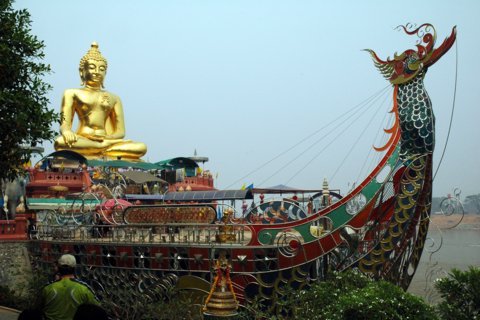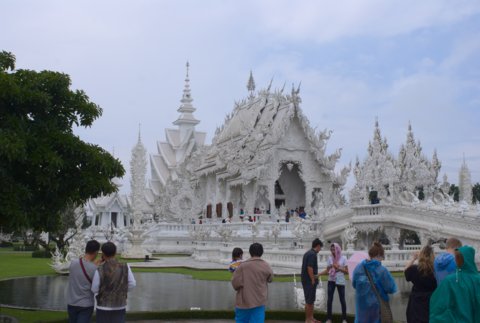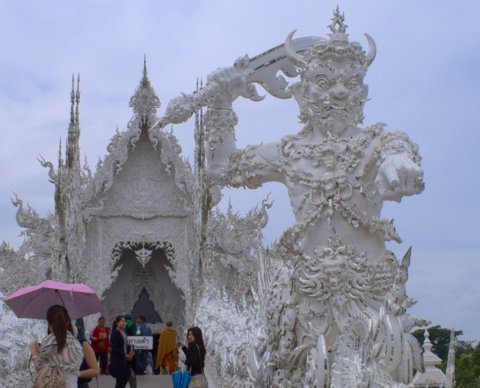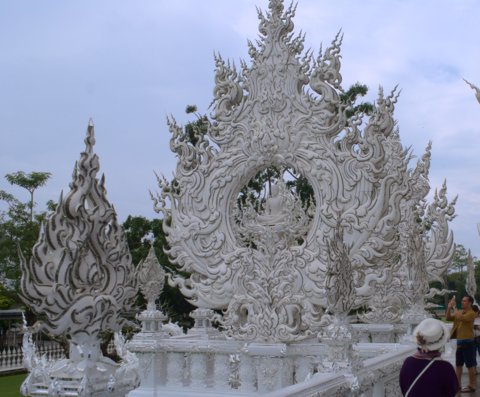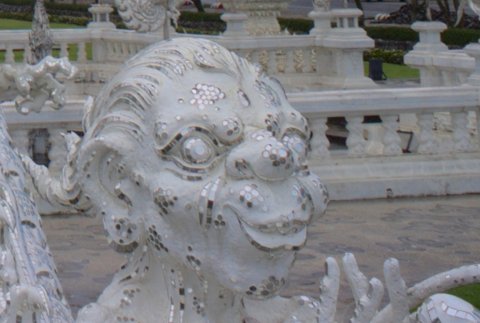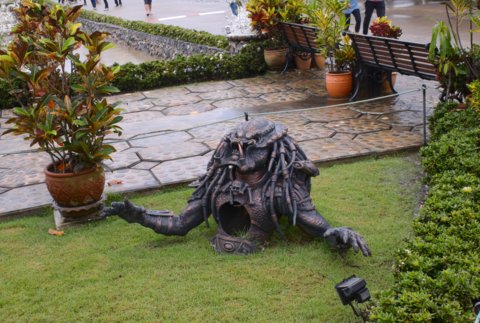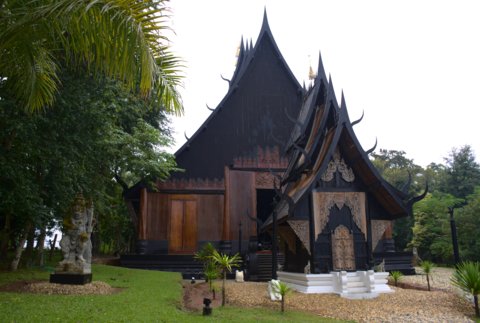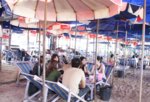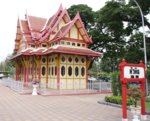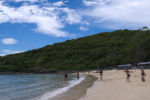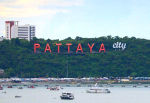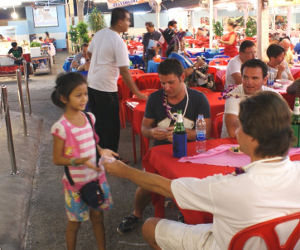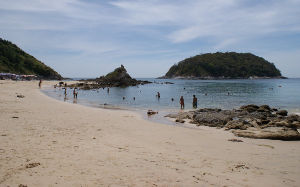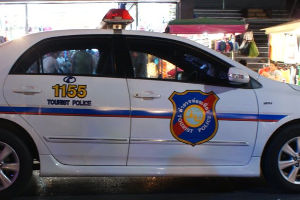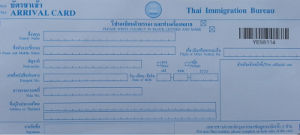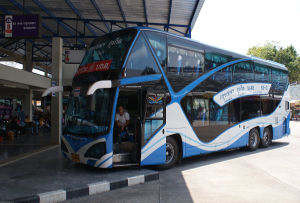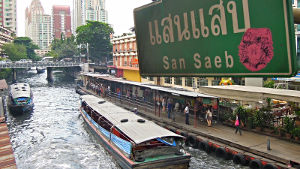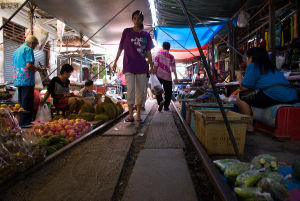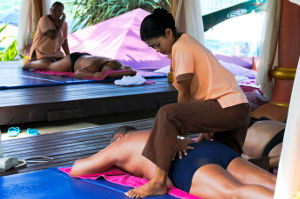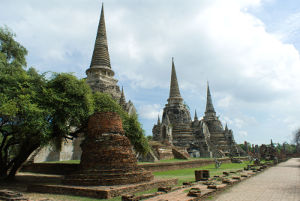Chiang Rai
In Chiang Rai, you will find light and darkness, and the province is in The Golden Triangle.
Chiang Rai is the name of both the province and its capital. In the capital, you will find light at The White Temple and darkness at the village known as The Black House; more about that further down in the article.
The Chiang Rai province is in Thailand's northeastern corner, where Thailand, Laos and Myanmar (Burma) meet, and where the rivers Ruak and Mekong meet. The area is in the middle of the infamous Golden Triangle, which at one time was the world's largest producer of opium and heroin.
You will find this big Buddha statue in the Thai part of the border area:
Today, drug production is virtually nonexistent in the Thai part of the Golden Triangle, while it is somewhat limited in Laos and also declining in Myanmar. On the Thai side of the borders, tourism is now a more important source of income, although drugs are still smuggled across the borders and south to Bangkok, from where they distribute the drugs to other parts of the world.
Not far from the Buddha above, you will find an opium museum that tells of the area's "golden" past. The museum even has a small opium field.
Visiting The Golden Triangle
You will find a wide range of excursions of 1-5 days duration in the Golden Triangle area. Typically, they include elephant riding and trekking in the jungle along the old opium routes; sailing on the Mekong River; visits to tribal villages; and visits to Laos and/or Myanmar. It is all garnished with fantastic nature and scenery.
You can find excursion offers at the tourist stalls in Chiang Rai and Chiang Mai. You can also find them on the internet; however, typically, they are cheaper at the tourist stalls.
Please be aware that if you go on excursions in this area, it will be a good idea getting various vaccines beforehand, typically in your own country.
The Capital Chiang Rai
In the city of Chiang Rai, you will find two attractions that you should visit. Both created by local artists albeit at different ends of the spectrum of light; white and black.
Most famous is Wat Rong Khun, also known as The White Temple. And it must be said that the temple lives up to the English name. It is very, very white! Even on a clouded day with a drizzle as when I took the photos below.
The Thai visual artist Chalermchai Kositpipat created the White Temple as a piece of art rather than an ordinary temple. And the temple certainly does not look like most other temples. On the way to the temple, you cross a small bridge; At the beginning of the bridge, you will pass a scultpure with hundreds of desperate arms raised from the ground.
The sculpture is named The Cycle of Rebirth, and it symbolizes that you have to forsake temptation, greed, and desire to achieve eternal happiness.
Two fiercely looking kinnaree warriors flank the bridge. In Thai mythology, a kinnaree is half-human and half-bird. Everywhere on the temple grounds, you will find sculptures and artwork. Most of it is white and decorated with small mirrors, making it reflect the lights and appear even brighter.
Not all the sculptures are white; this predator escaped Arnold Schwarzenegger only to get caught in the lawn in front of the temple.
After all the whiteness at The White Temple, you may need to counter it with some some darker colours; you will find those at The Black House.
GPS to The White Temple: 19.824093, 99.763754. Open from 8-18 (8 AM - 6 PM). Entrance is free for the locals, and 50 baht for tourists.
The Black House
Actually, The Black House is a black village. The Thai name is Baan Dam, and Baan can mean both house and village; dam means black. The English name may be due to a very big and dominating house you will find near the main entrance to the village.
It may be difficult to estimate the size of the house in the first photo below; the door is about 4 meters (13 feet) high. The next photo from inside the house where a long table goes all the way through the house gives you a better impression of the size.
Besides the long table in the middle of the building, you will find smaller tables scattered around in the room; however, smaller does not mean they are small. Very few people have room for the small tables in their house.
The chairs are not like any chairs you will find in an ordinary house either. The chairs are decorated with buffalo horns and adorned with a buffalo skull with horns. They may not look comfortable; however, they do look impressive.
The village was created by the artist Thawan Duchanee, who lived here until his death in 2014. The main components in the village are unpainted and black wood and wood slabs; weapons; and fur, skulls, and horns of animals.
GPS to The Black House: 19.992222, 99.860278. Open from 9-17 (9 AM - 5 PM). Entrance is 80 baht.
The Climate in Chiang Rai
While the south of Thailand has two seasons, a hot season and a season that is both hot and wet, northern Thailand has three seasons. You may even have to wear a coat here in the winter when the temperature at night can get below 15°C (59°F). In the mountains the temperature can drop even further; thus, if you go on an excursion where you spend the night in the mountains, you better bring more clothes than shorts and a T-shirt.
The rainy season between May and October is not as wet as in the south. The rainy season peaks in July, August, and September, with up to 360 mm (14.2 inches) of precipitation in August. That may sound scary if you are not used to tropical climate; however, most of the rain falls in short but heavy showers, and much of it falls in the night.
The average day temperature is a little less than 30°C (86°F) most of the year, although, in December, January, and February, it is about 20°C (68°F), and in April the temperature can get higher than 35°C (95°F).
How to Get to Chiang Rai
From Bangkok, the easiest way to get to Chiang Rai is flying. You can get there by bus; however, I will not recommend the bus. The trip by bus is 11 hours and not comfortable.
There is no train to Chiang Rai, although you can take the train to Chiang Mai (12 hours) and from there take a bus (3 hours). A better choice from Chiang Mai is to take a bus to Thaton and the river Kok, and from there take a long-tail boat to Chiang Rai. The trip will take more time; however, you can enjoy the nature along the river.
For local travel in Chiang Rai, the price for tuk-tuks and songthaews are reasonable compared to many other places in Thailand. As always, remember to agree on a price beforehand.
You will find cheap hotels as well as expensive and extremely luxurious hotels in the Chiang Rai area at agoda.




